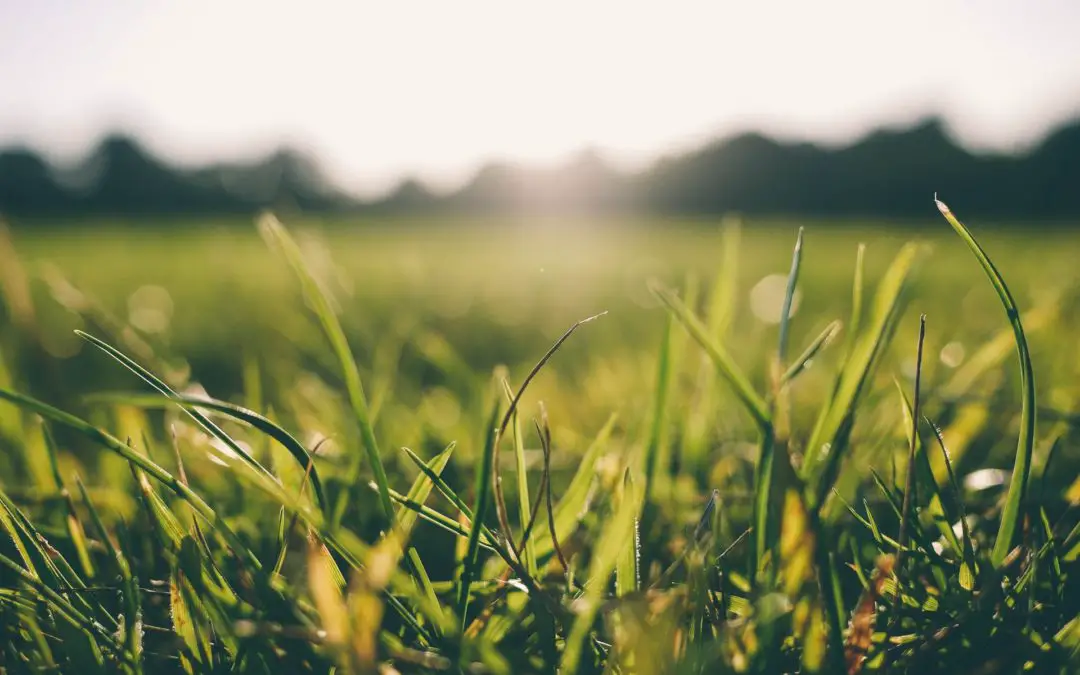Your neighbors or maybe you yourself are in the habit of dethatching every spring. But is thatch really a problem? How much is too much? Should I be de-thatching every year? Well… it depends!
Thatch is good for your lawn up to 1/2” thick. The layer of dead organic matter is made up of dead stems, rhizomes and blades. Thatch shades grass crowns, roots and soil. It reduces water evaporation, cools the soil, and cushions foot traffic in the heat of summer. It insulates grass through the cold of winter. Thatch 1” or thicker can host mice, beetles and other pests. It can prevent light rains from making it down to the roots. It can trap fertilizer near the growing grass blades, causing chemical burn. Thatch will break down naturally over time. If de-thatching is to be done, it should be done in spring, on lawns thicker than ½”, when growth is vigorous so recovery from damage will be quick.
What is thatch?
Before we get into the benefits and problems with having a layer of thatch – let’s define exactly what thatch is. Thatch is a combination of generally dead material that accumulates on the soil surface. It is an accumulation of turf-grass stems, roots, and other matter. So how does it form?
Benefits of thatch
- Shades the crown and roots from direct sun and wind, giving a milder growing micro-climate
- Slows water loss through evaporation from wind and sun
- Cools the soil in the heat of summer
- Provides a cushion for foot traffic, making the grass more resilient
- It protects grass through the winter in colder climates
Cons of thatch
- If it’s thick, and rains are light, it can prevent water from making it down to the roots where it can be absorbed.
- It can trap fertilizer near grass blades, where it can burn the vegetation before it’s dissolved and makes its way down to the soil level
- It can be a home to mice, beetles, and other critters if it’s thick enough
- The look of your lawn can change
How does Thatch Form?
It forms naturally as plants grow and old blades and roots are shed. With a well-fertilized and well-watered lawn thatch buildup is inevitable. Thatch buildup occurs when organic debris is produced faster than it can decompose and break down.
A common misconception is that thatch is caused by leaving grass clippings on the lawn. Cutting regularly means that shorter sections of the leaf blade will be removed, these small pieces will fall down and come into contact with the soil and more microorganisms, and decompose more quickly. Grass clippings are high in water and nutrients, this means they’re a great natural fertilizer for your lawn.
Other contributors to thatch formation are soil type, compaction, and PH. When the plant is stressed roots and stems are shed more quickly. This shed material contributes to thatch. These factors may or may not be under your control, so what can you do about it?
De-thatching
De-thatching is the solution for extremely thick, dense thatch. A de-thatching or power-raking machine is the ticket. For thinner thatch, a viable alternative or complimentary treatment is aeration. Although, chances are you can get away with a pretty thick layer of thatch without any issues.
De-thatching is the process of removing thatch from a lawn. This is generally accomplished on a residential level with a walk-behind machine called a power-rake – also called a de-thatcher. The machine has a row of spinning flail blades that kick up the dead material. This material is then bagged and optimally composted!
Why De-thatch or Power-rake?
Thatch can be a nasty problem. A thick layer holds in moisture and is a harbor for pests and disease, and we don’t want that. De-thatching removes this layer and helps air, water and fertilizer more easily penetrate to your roots. Your grass might not thank you, but you’ll thank yourself every time you look out the window.
Renting a de-thatching machine can be done from a lot of box stores and hardware stores. The cost should start somewhere around $50. If you want to save some money, you could get together with a few neighbors and split the cost.
When I was running my landscaping company I would de-thatch a yard, and then talk to a few neighbors in the area. Often I could set up a bunch of houses on the same street for the next year. I offered a lower price, and they were happy to mention it to a few other people to keep the street looking sharp.
If you’re really looking to de-thatch on a low budget, or if you’re looking for a good workout, you can dethatch with
Core Aeration
Aeration brings important micro-organisms to the surface. These little beings really help break down the thatch. Combined with de-thatching, aeration can take a distressed lawn and give it the boost it needs.
By bringing up soil and micro-organisms, decomposition of organic matter is accelerated. It also helps fertilizer, water, and grass roots penetrate deeper. There’s less run-off of fertilizer and water. Grass roots are deeper and more drought tolerant.
Do you need to De-thatch?
If you have a lawn that looks green on top, but brown underneath, you may need to dethatch. Another case is when mowing causes the lawn to look dead, brown, and scalped. This is simply the thatch tangling up the green leaf blades. If your lawn is yellow or brown and thinning, and you can’t see any bare ground, you definitely need to dethatch.
A good rule is to de-thatch if the thatch is 1.5 cm (half inch) thick or greater. At this length disease and pests becomes a problem that’s only going to get worse.
It’s also best to dethatch when the lawn is growing vigorously, probably in the spring or early summer.
When is the best time to De-thatch?
In a perfect world, de-thatch in the early spring through early summer. But, lawncare and landscape maintenance companies will be very busy in the spring, and costs may be higher. The grass is just coming out of dormancy and there is little vegetation for the flail blades to damage. The grass will also be entering vigorous growth.
The faster the grass is growing, the quicker it will recover from the damage caused during de-thatching. De-thatching is a rough mechanical process. Usually metal prongs or flails are used to whip the thatch up to the surface.
When not to De-thatch
Freshly sodded lawns should not be de-thatched. New sod generally has little thatch, but it never hurts to mention it just in case. Freshly seeded lawns that are less than 2 years old shouldn’t be de-thatched.
Because de-thatching causes so much damage, and provides protection for grass in the winter in colder climates, don’t de-thatch in the fall. If the grass is beginning to go dormant in the fall, and you de-thatch it, it will have to weather the whole winter in a damaged, weakened state. It will probably be fine, but why not give it every chance and de-thatch in the spring or early summer?
How do I prepare my lawn for de-thatching?
So you’ve decided you need to de-thatch, now what? If you use a bagging mower it’s a good idea to give the lawn a cut. This sucks up some of the loose debris and ensures a manageable grass length.
A de-thatcher (power rake) has moving parts that extend further than a mower. Because of this, now is a good time to mark any sprinkler heads, or anything immovable that might not be visible. Home improvement stores sell cheap bundles of fluorescent flags on stiff metal wires, these work great. Now that your due diligence is out of the way, go ahead and de-thatch!
I’m done right? Well…
Right after de-thatching is a great time to top-dress. If you’re not familiar with what this is, it’s simply adding a layer of dirt or compost to your lawn. Organic material is removed when lawnmower clippings are bagged or blown away. Top dressing replaces it and rejuvenates your lawn with new nutrients.
It’s also a great opportunity to overseed your lawn if you’d like it a little thicker. time to fertilize and overseed. Thatch blocks air, water, and fertilizer penetration. Now it’s gone!

I’m Alex Lafreniere. I learned a lot about plants when I built and operated a landscaping company. But, there’s always more to learn. Ever since travelling across the world, I’ve wanted to find ways to bring more tropical and exotic plants into my life. This is the site where I share everything I’ve learned with you.
This site is owned and operated by Plant Hardware, a sole proprietor headquartered in Calgary, Canada. Plant Hardware is a participant in the Amazon Services LLC Associates Program, an affiliate advertising program designed to provide a means for sites to earn advertising fees by advertising and linking to Amazon.com.Plant Hardware may also participate in affiliate programs with Bluehost, Clickbank, CJ, ShareASale, and other sites. Plant Hardware is compensated for referring traffic and business to these companies.

